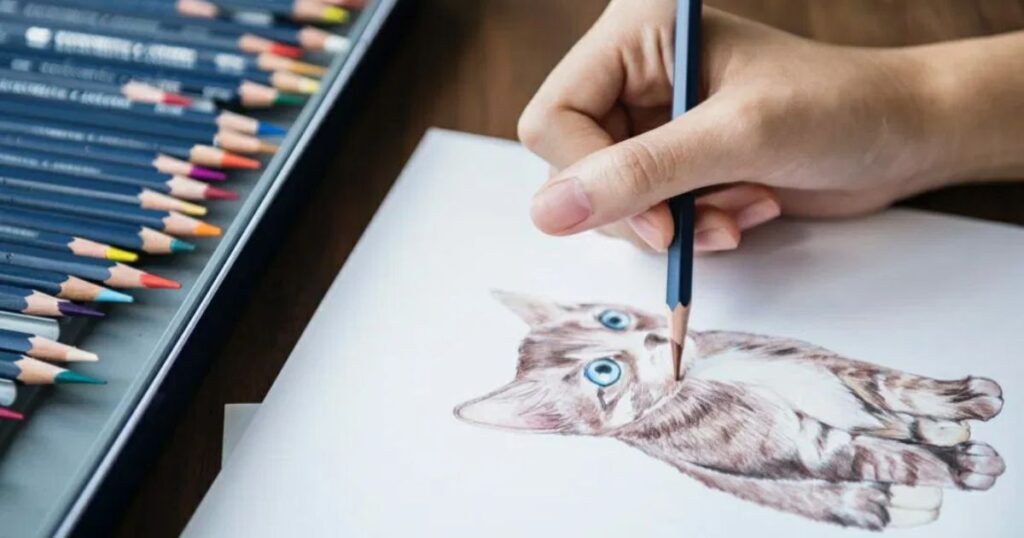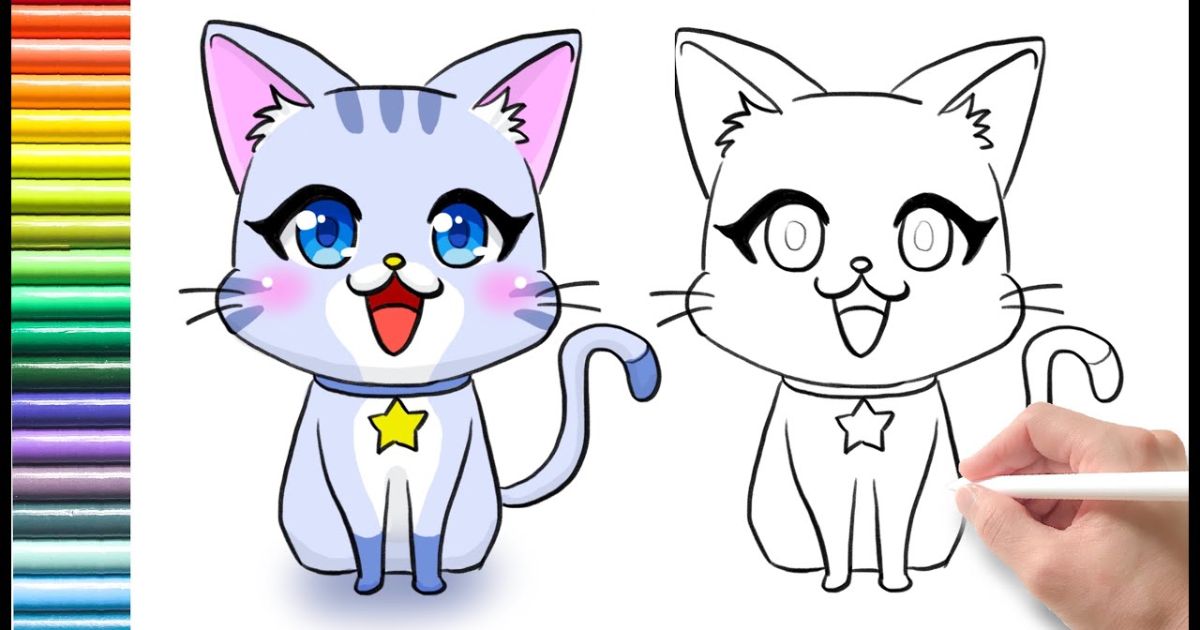Ever gazed at a feline friend and thought, “I’d love to capture that on paper”? You’re not alone. Cat lovers and artists alike have long been captivated by the grace, mystery, and charm of our purring companions. This guide will walk you through the drawing:a4z_-ymtkr8= cat technique, a method that’s taking the art world by storm. Whether you’re a seasoned sketcher or just starting, you’ll find tips and tricks to bring your feline visions to life. Drawing:a4z_-ymtkr8= Cat
Understanding Cat Anatomy
Before you put pencil to paper, let’s dive into the blueprint of our feline friends. Understanding a cat’s anatomy is like having a roadmap for your drawing:a4z_-ymtkr8= cat journey.
Cats are marvels of nature, built for agility and stealth. Their skeletal structure is the foundation of their form. Picture a flexible spine that can twist and turn, allowing for those acrobatic leaps. Connected to this are powerful hindquarters, ready to spring into action at a moment’s notice.
But it’s not just bones we’re dealing with. The muscle groups of a cat are what give it its distinctive shape. From the rounded shoulders to the sleek flanks, each muscle plays a role in the cat’s silhouette. When you’re working on your drawing:a4z_-ymtkr8= cat, keep in mind how these muscles interact with the skeleton to create the overall form.
Here’s a quick breakdown of key anatomical features to focus on:
- Head: Rounded with a short muzzle
- Eyes: Large and almond-shaped
- Ears: Triangular and erect
- Body: Sleek and elongated
- Legs: Muscular with retractable claws
- Tail: Long and expressive
Remember, different breeds have their unique proportions. A Persian’s squished face is a world apart from a Siamese’s elongated features. As you practice the drawing:a4z_-ymtkr8= cat technique, you’ll learn to adapt to these variations.
Initial Sketch and Refinement
Now that we’ve got the basics down, let’s get sketching! The drawing:a4z_-ymtkr8= cat method starts with simple shapes. Think of it as building blocks for your feline masterpiece.
Begin with circles and ovals. A large circle for the body, and a smaller one for the head. Ovals for the legs and tail. Don’t worry about perfection – these are just guidelines. As you connect these shapes, you’ll see a cat-like form emerging.
Next, refine your drawing:a4z_-ymtkr8= cat outline. Smooth out the curves, and add the dip of the spine, and the arch of the neck. This is where your knowledge of cat anatomy comes into play. Visualize the muscles beneath the fur, the way the legs connect to the body.
“In every cat, there’s a wild beast lurking just beneath the surface. Your job as an artist is to capture that essence.” – Anonymous Cat Artist
As you work, keep your lines light. The beauty of the drawing:a4z_-ymtkr8= cat technique is its flexibility. You’ll be refining and adjusting as you go, so don’t commit too hard to any one line just yet.
Adding Facial Details and Texture

Now we’re getting to the good stuff – the face. A cat’s face is its calling card, full of personality and expression. In the drawing:a4z_-ymtkr8= cat method, we pay special attention to these details.
Let’s start with the eyes. They’re not just circles – they’re almond-shaped, with a distinctive slant. The pupil can be a thin slit or a wide oval, depending on the light. Remember, cats’ eyes are proportionally large for their faces, so don’t be shy about making them a focal point.
The nose is small and triangular, with nostrils that are just slight indentations. The mouth is usually a simple line but can curve into a content “smile” or open for a meow or hiss.
Now, for the whiskers – a cat’s pride and joy. These should be long, sweeping lines extending from the cheeks and above the eyes. They’re not just decorative; they’re crucial sensory tools for our feline friends.
When it comes to fur texture, the drawing:a4z_-ymtkr8= cat technique offers a range of approaches:
- Short, quick strokes for short-haired cats
- Longer, flowing lines for long-haired breeds
- Subtle shading indicates color variations
Remember, less is often more. Suggest the texture rather than trying to draw every single hair.
Shading and Highlighting
Light and shadow – these are the magic ingredients that bring your drawing:a4z_-ymtkr8= cat to life. Understanding how light falls on a cat’s form is crucial for creating depth and dimension.
First, decide where your light source is coming from. Is it overhead, like sunlight? Or from the side, like a lamp? This will determine where your highlights and shadows fall.
For shadows, use soft, smooth strokes in the areas where light doesn’t directly hit. Common shadow areas include:
- Under the chin
- Along the belly
- In the creases of the legs
Highlights are where the light hits directly. These areas should be left lighter or even untouched by your pencil. Key highlight areas often include:
- The top of the head
- Along the back
- On the cheekbones
The drawing:a4z_-ymtkr8= cat method encourages experimentation with different shading techniques. Try cross-hatching for a textured look, or smooth blending for a softer appearance. The key is to build up layers gradually, creating a sense of depth and form.
Drawing Different Types of Cats
One of the joys of the drawing:a4z_-ymtkr8= cat technique is its versatility. Whether you’re sketching a sleek Siamese or a fluffy Maine Coon, the basic principles remain the same.
For short-haired cats, focus on the smooth contours of the body. Your shading should be subtle, with just enough texture to suggest fur. Long-haired cats, on the other hand, are all about the fluff. Use flowing lines and plenty of texture to capture that luxurious coat. Drawing:a4z_-ymtkr8= Cat: A Comprehensive Guide.
Here’s a quick reference for some popular breeds:
| Breed | Key Features | Large-size, tufted ears |
|---|---|---|
| Siamese | Slim body, angular face | Emphasize long lines and almond-shaped eyes |
| Persian | Round face, short muzzle | Focus on fluffy texture and large, round eyes |
| Maine Coon | Large size, tufted ears | Highlight ear tufts and long, fluffy tail |
| Sphynx | Hairless, wrinkled skin | Pay attention to skin folds and large ears |
Remember, each cat is unique. Even within breeds, there’s plenty of variation. The drawing:a4z_-ymtkr8= cat method is all about capturing that individual personality.
Creative Possibilities and Unique Features

Now that you’ve got the basics down, it’s time to let your imagination run wild! The drawing:a4z_-ymtkr8= cat technique is just a starting point – where you take it is up to you.
Try experimenting with different poses. Cats are incredibly flexible and capable of contorting into all sorts of interesting shapes. How about a cat mid-stretch? Or one curled up in a tight ball? Each pose presents its challenges and opportunities for creativity.
Don’t be afraid to exaggerate features for effect. Maybe you want to create a cartoon-style cat with oversized eyes and tiny paws. Or perhaps you’re going for a more realistic look, but want to emphasize the regal bearing of your feline subject.
Here are some ideas to spark your creativity:
- A cat in motion, pouncing on an unseen prey
- A close-up of a cat’s face, focusing on the intricate details of the eyes
- A sleeping cat, showcasing the peaceful curves of its form
- A curious cat, with one paw raised as if reaching out to the viewer
Remember, the drawing:a4z_-ymtkr8= cat method is all about capturing the essence of “catness” – that ineffable quality that makes cats so fascinating to us. Whether you’re going for realism or whimsy, keep that feline spirit at the heart of your work. Drawing:a4z_-ymtkr8= Cat: A Comprehensive Guide.
Final Touches
You’re in the home stretch now! The final touches are what will make your drawing:a4z_-ymtkr8= cat pop off the page.
This is the time to refine your details. Go over your lines, darkening where necessary to create contrast. Add in those tiny details that bring character – the individual whiskers, the texture of the nose, the glint in the eye.
Consider adding some background elements to contextualize your cat. A simple shadow can ground your subject, or you might suggest a window sill or a cozy cushion. Just remember, the cat should remain the star of the show.
Finally, don’t forget the drawing:a4z_-ymtkr8= cat signature flourishes. These might be:
- A particular way of rendering whiskers
- A unique approach to fur texture
- A characteristic style of eyes
These personal touches are what will make your drawing:a4z_-ymtkr8= cat uniquely yours. Drawing:a4z_-ymtkr8= Cat: A Comprehensive Guide. Drawing:a4z_-ymtkr8= Cat: A Comprehensive Guide.
Tips for Capturing a Cat’s Personality
Cats are more than just pretty faces – they’re individuals with distinct personalities. The best drawing:a4z_-ymtkr8= cat artists know how to capture that essence on paper.
Observation is key. Spend time watching real cats. Notice how they move, how their expressions change, the way their tails twitch when they’re annoyed or excited. These subtle cues can bring your drawings to life.
Consider these personality traits and how to express them:
- Playful: Ears forward, eyes wide, body in motion
- Aloof: Half-closed eyes, tail wrapped around the body
- Curious: Head tilted, one paw slightly raised
- Content: Eyes closed, body relaxed
Remember, the drawing:a4z_-ymtkr8= cat technique is about more than just technical skill – it’s about capturing the spirit of your subject. Drawing:a4z_-ymtkr8= Cat
Conclusion
Congratulations! You’ve just taken a deep dive into the world of drawing:a4z_-ymtkr8= cat artistry. From understanding feline anatomy to capturing personality quirks, you’re now equipped with the tools to create stunning cat portraits.
FAQs
- What materials are best for drawing:a4z_-ymtkr8= cats?
While you can start with any pencil and paper, many artists prefer a range of graphite pencils (2H to 6B) and smooth drawing paper for the best results. - How long does it take to master the drawing:a4z_-ymtkr8= cat technique?
Like any skill, it varies per person. With regular practice, you should see significant improvement within a few months. - Can I use this method for other animals?
Absolutely! While tailored for cats, the principles of the drawing:a4z_-ymtkr8= technique can be adapted for other animals too. - What’s the best way to practice drawing:a4z_-ymtkr8= cats?
Daily sketching is key. Try quick gesture drawings of cats in various poses, focusing on capturing the essence rather than details. - How do I make my drawing:a4z_-ymtkr8= cats look more realistic?
Focus on accurate proportions, subtle shading, and capturing the unique textures of fur. Studying real cats or high-quality photos can help immensely.



